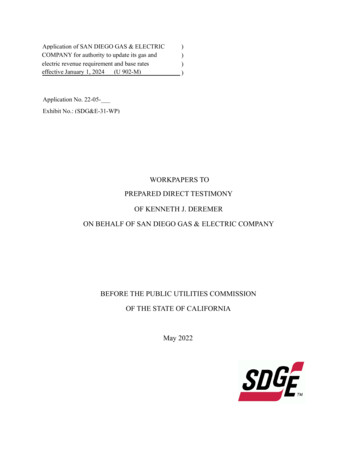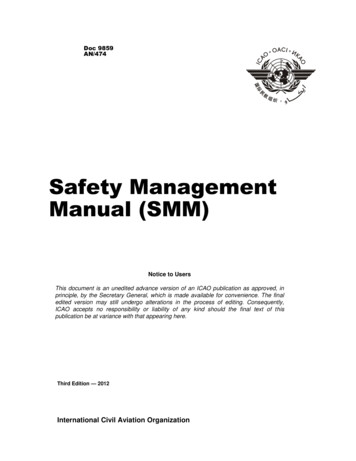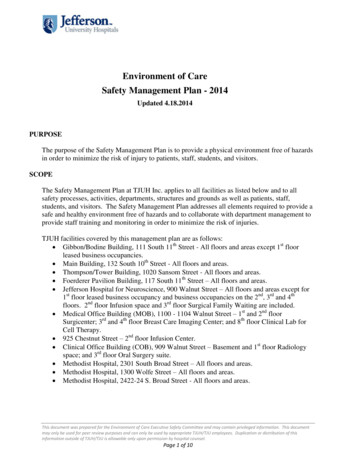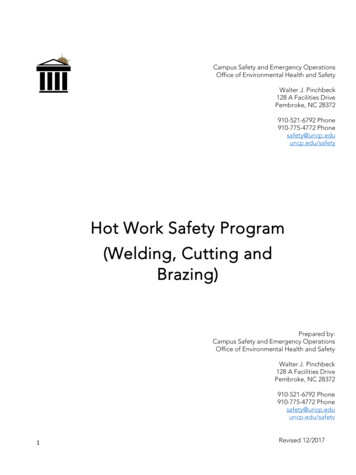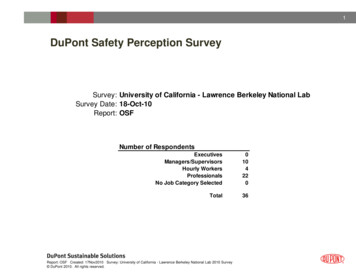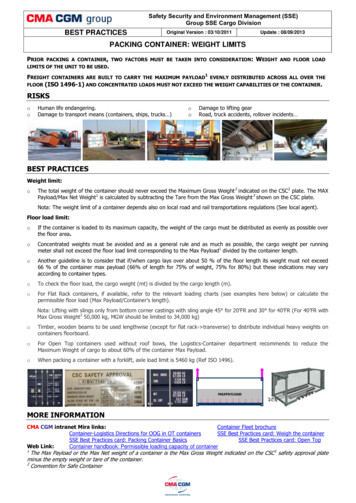
Transcription
Safety Security and Environment Management (SSE)Group SSE Cargo DivisionBEST PRACTICESOriginal Version : 03/10/2011Update : 08/09/2013PACKING CONTAINER: WEIGHT LIMITSPRIOR PACKING A CONTAINER, TWO FACTORS MUST BE TAKEN INTO CONSIDERATION: WEIGHT AND FLOOR LOADLIMITS OF THE UNIT TO BE USED.FREIGHT CONTAINERS ARE BUILT TO CARRY THE MAXIMUM PAYLOAD1 EVENLY DISTRIBUTED ACROSS ALL OVER THEFLOOR (ISO 1496-1) AND CONCENTRATED LOADS MUST NOT EXCEED THE WEIGHT CAPABILITIES OF THE CONTAINER.RISKSooHuman life endangering.Damage to transport means (containers, ships, trucks )ooDamage to lifting gearRoad, truck accidents, rollover incidents BEST PRACTICESWeight limit:oThe total weight of the container should never exceed the Maximum Gross Weight3 indicated on the CSC2 plate. The MAXPayload/Max Net Weight1 is calculated by subtracting the Tare from the Max Gross Weight 3 shown on the CSC plate.Nota: The weight limit of a container depends also on local road and rail transportations regulations (See local agent).Floor load limit:oIf the container is loaded to its maximum capacity, the weight of the cargo must be distributed as evenly as possible overthe floor area.oConcentrated weights must be avoided and as a general rule and as much as possible, the cargo weight per runningmeter shall not exceed the floor load limit corresponding to the Max Payload1 divided by the container length.oAnother guideline is to consider that if/when cargo lays over about 50 % of the floor length its weight must not exceed66 % of the container max payload (66% of length for 75% of weight, 75% for 80%) but these indications may varyaccording to container types.oTo check the floor load, the cargo weight (mt) is divided by the cargo length (m).oFor Flat Rack containers, if available, refer to the relevant loading charts (see examples here below) or calculate thepermissible floor load (Max Payload/Container’s length).Nota: Lifting with slings only from bottom corner castings with sling angle 45 for 20’FR and 30 for 40’FR (For 40’FR withMax Gross Weight3 50,000 kg, MGW should be limited to 34,000 kg)oTimber, wooden beams to be used lengthwise (except for flat rack- transverse) to distribute individual heavy weights oncontainers floorboard.oFor Open Top containers used without roof bows, the Logistics-Container department recommends to reduce theMaximum Weight of cargo to about 60% of the container Max Payload.oWhen packing a container with a forklift, axle load limit is 5460 kg (Ref ISO 1496).MORE INFORMATIONCMA CGM intranet Mira links:Container Fleet brochureContainer-Logistics Directions for OOG in OT containersSSE Best Practices card: Weigh the containerSSE Best Practices card: Packing Container BasicsSSE Best Practices card: Open TopWeb Link:Container handbook: Permissible loading capacity of container1The Max Payload or the Max Net weight of a container is the Max Gross Weight indicated on the CSC 1 safety approval plateminus the empty weight or tare of the container.2Convention for Safe Container
Safety Security and Environment Management (SSE)Group SSE Cargo DivisionBEST PRACTICESOriginal Version : 03/10/2011Update : 08/09/2013PACKING CONTAINER: WEIGHT LIMITS3Max Gross Weight: Maximum permissible weight (Max Payload Tare/Empty weight of the container).
Safety Security and Environment Management (SSE)Group SSE Cargo DivisionBEST PRACTICESOriginal Version : 11/23/2009Update : 07/15/2013PACKING CONTAINER: STONE BLOCKSCMA CGM has experienced serious incidents pertaining from improper securing of natural stone blockswhich sometimes were exceeding standard containers capability.HAZARDSThe arrangement of blocks inside containers must not exceed the load limits of the container. A goodweight distribution on container’s floor is paramount for safety.Container side and end walls are not strength enough to prevent cargo shifting and the packing of suchgoods into closed container do not exempt shippers from bracing and securing them in such a waythey can withstand transportation stresses (Rolling, Pitching, handling, Lifting, road braking ) withoutmoving.RISKSoooSevere casualties even human death.Damages to transport means (containers, ships, trucks ), to lifting gears.Ship’s detention for repairs.BEST PRACTICESThank you to refer to Container-Logistics Dpt Guidelines: “Marble and Granite blocks guidelines”SSE recommendation is not to accept single blocks of more than 20 tons but within theGroup, some Lines do accept single stone blocks of more than 20 tons but less than 26tons provided their weights are spread over 3 wooden planks at least 3 meters long (3m x10cm x 10cm) and that they are wedged on all sides.Suitable containers:oo Flat rack containers for heavy stoneblocks.o Sound 30 metric tons tested 20’ standard ocontainers.o Letter of Indemnity (LOI “damage tocontainer”).o Container weight limits not to be exceeded.oo Blocks not in contact with container’s flooro No high stacking of stone blocks.oo Longitudinal wooden beams as strong aspossible to supply friction and to distribute theweight.Note: Lashing points inside closed containers are limitedoWedging on all sides, longitudinal andtransverse securing of blocks, braced to theside/end walls.Transverse shores to transfer their securingload through longitudinal cross-beams onto asmany corrugations of the container walls aspossible.Centre of gravity as close as possible to thecentre of the container.Bottom of the laden container to be inspectedwhile lifting for the 1st time at packer’spremises.in strength (1.5 mt).MORE INFORMATIONCMA CGM intranet Mira links:ooSSE Best Practices cards: BP Packing Container BasicsBP Packing Container InspectionBP Packing Container Weight LimitsContainer-Logistics Dpt Guidelines and LOI blank form: Marble and Granite blocks guidelinesDisclaimer: This document is for internal use only and shall not be provided to external parties.
Safety Security and Environment Management (SSE)Group SSE Cargo DivisionBEST PRACTICESOriginal Version : 11/23/2009Update : 07/15/2013PACKING CONTAINER: STONE BLOCKSDO’s and DON’TsThe block(s) is(are) tooheavy for the containerand this one is useless. Donot exceed the containerMax Payload and/or thePermissible Line Load (20’GP: 5mt/lm)The block rests directly oncontainer’s floor. The flooris damaged.There is no cross beam todistribute forces on thebottom of the side wall ofthe containers. Thecontainer is damaged andblock may escape atrollingThe small block is freeand can move at rolling orpitching.Do not stack one blockover one anotherBlocks laid ontransverse planks withwooden bracing forlengthwise securingand loop lashing withchains.Block laying on 2 timberbeams but these ones aretoo short and too thin andthere is no lateral andlongitudinal securingCheck the containerMax Payload (or netweight) and don’texceed the floor loadlimit (see BP PackingContainers: Weight limits)Pressure distributed toside walls through crossbeamsNo commentDisclaimer: This document is for internal use only and shall not be provided to external parties.2/2
Big Marbles and Stone blocksStuffing guidelinesBy Mohd SaimDate: 15/05/2008
High risk of major accidentsMarble notsecuredproperlyand/or not inthe center ofcntr may moveand createsome majoraccident forequipment andpersons.Un-acceptable
Ordinary damagesStuffing withoutsupportingtimbers willdamage thecntr floor.
Improper StuffingImbalanceddistribution of weightto one side panel.No wedging/chokes toprevent movement.Lashing points arenot strong enough totake the stress fromweight of cargoBottom supports notbig enough to spreadthe weight over alarge area and toprevent floor frombeing damagedUn-acceptable
Improper StuffingImbalanceddistribution ofweight to one sidepanel.No wedging/chokesto preventmovement.No/insufficientBottom supportsUn-acceptable
Improper Stuffing No protectionFor side walls No protectionAgainst movement No protectionfor the floor Danger forpeople handingthe containerUn-acceptable
Improper Stuffing No protectionfor side walls No protectionagainstmovement No protectionfor the floor Danger forpeople handingthe containerUn-acceptable
Possible Stuffing Example Stopper timbers(or chokes) mustbe used on front& back sides andbig timbersunderneath theblock overenough length. Chokes must beused to protectmovement ofcargo inside thecntr.
Another example of possible stuffingThe StoneIs protectedFrom all sidesAs well as theBottom.The weight isEqually distributedAll over thecontainer floor
Big block Stuffing example
Guidelines for stuffing 30 tonnes tested containers more than 6 years old to beused. Weight on floor max 5 tonnes per linear meter. The block MUST not touch the floor (should slid and lay onlong timbers). Timbers spread underneath the block (see slide 5).Example; 1 block of 20T 4 meter long Timber. Center of gravity of cargo should be as close as possible tothe centre of the container.
Guidelines for stuffing Wedging on all sides on the container.Recommended wedging: height 10% minimum as high as theblock.Recommended wedgings 1 per 0,5 meter.Example: 1.5 x 2 meters block 3 wedges (chokes) minimumon each side and 2 wedges minimum on front and back. Lashing must also be used in addition to the above. MnR office in charge (local or MnR HO) have to be contactedwith specs of cargo and lashing wedging method pictures.
Must and Most NotsMust Do Stopper planks and chokes/wedges bottom timber pieces / LegsMust Not Do One block must not be more than 20 tonnes The block must not touch the floor or any walls or door The Block must not move inside the container.
Letter of indemnityLetter of Indemnity is a must with for this cargo.
G Safety Security and Environment Management (SSE) roup SSE Cargo Division BEST PRACTICES Original Version: 11/23/2009 Update : 07/15/2013 PACKING CONTAINER: STONE BLOCKS Disclaimer: This document is for internal use only and shall not be provided to external parties. CMA CGM has experienced serious incidents pertaining from improper securing of natural stone blocks




